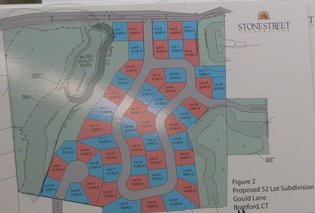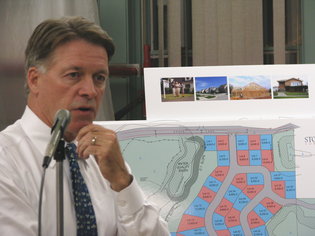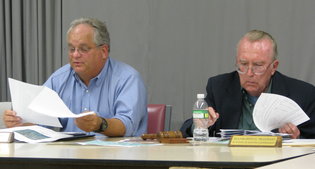 A plan to build 52 “workforce” homes on Gould Lane in Branford is being proposed by a Rhode Island developer in conjunction with the AFL-CIO Housing Investment Trust. It would be the first housing project in the state financed by the union’s pension fund.
A plan to build 52 “workforce” homes on Gould Lane in Branford is being proposed by a Rhode Island developer in conjunction with the AFL-CIO Housing Investment Trust. It would be the first housing project in the state financed by the union’s pension fund.
“This proposal is unique,” said attorney Christopher Smith, who represents the developer and owner, Stonestreet Corp. of East Providence, R.I. He explained that the homes would be built with union money, by union construction workers, and marketed to working class families. “This is true starter-home, workforce housing,” Smith said.
 Paul Barrett (pictured), Northeast regional marketing director for the AFL-CIO Housing Investment Trust, said the union has been looking for investment projects in the state. “It would allow us to bring pension funds to Connecticut for the first time,” Barrett said.
Paul Barrett (pictured), Northeast regional marketing director for the AFL-CIO Housing Investment Trust, said the union has been looking for investment projects in the state. “It would allow us to bring pension funds to Connecticut for the first time,” Barrett said.
However, the project faces several hurdles, including a zoning change that would allow more homes to be built on smaller lots. The Planning and Zoning Commission (P&Z) held a public hearing Thursday night on Stonestreet’s request to rezone a 25-acre parcel at 47 Gould Lane, located about a half-mile from Leetes Island Road, near Exit 56.
The property is currently zoned R-4, which allows a minimum lot size of 20,000 square feet, meaning that 24 homes could be built on the Gould Lane parcel. The developer is requesting a change to R-1, which allows a minimum lot size of 6,000 square feet and a potential of three times as many homes.
Smith, an attorney with Shipman & Goodwin of Hartford, said about 30 to 40 percent of the site cannot be developed because of wetlands and steep slopes. “It’s not a tripling of the density… it would be a doubling,” he said. The 52 single-family homes would feature three or four bedrooms and range in price from $350,000 to $375,000.
Ellsworth McGuigan, who chairs the P&Z, asked why the developer didn’t submit the proposal as a Planned Development District (PDD) which links zoning changes to specific site plans. McGuigan said some positive ideas were presented during the hearing, but he is concerned that the project could change once the land is rezoned.
“Why not present it together so the zone change is tied to the proposal?” McGuigan asked. “I feel safer with something like that,” he said in regard to a PDD. “There doesn’t seem to be a guarantee that this (proposed project) would occur with a zone change.”
Commissioner Charles Andres, however, said he has some reservations about the PDD concept if it allows too much flexibility.
Site plans, which have not yet been submitted, must be approved by P&Z.
Local environmentalist Bill Horne, who was the only member of the public to offer comment, asked the commission to deny the zoning change. Horne said a “simple zone change” would not prevent the developer or any subsequent developer from “pushing it to the max” in terms of housing units and density.
“There are a lot of things that need to be done if this is going to work,” Horne said.
Smith told the commission that the developer is looking for guidance and would consider other options for the zoning format. “If the preference is a PDD …that’s certainly something Stonestreet could do,” he said.
After conferring briefly with Stonestreet officials, Smith offered another alternative that would place stipulations and conditions on the zoning change. For example, Smith said the developer would agree to tying the zoning change to a maximum of 52 single-family homes and no duplexes.
“You would have the protection you’re looking for,” Smith said, adding that Stonestreet would present the site plans for approval in a specified time. “If you don’t approve something in a set period of time, the zone change would be null and void.”
Smith said the development team and the union believe the homes will be marketable. “That’s where, hopefully, the market is going to be,” he said in regard to the price and size of the homes. “People are not going to be building McMansions.”
When asked by Commissioner Andres if the developer would consider building 24 homes, as permitted under the current zoning, Smith said it would not be “financially feasible.”
Christopher Reynolds, vice president of Stonestreet, outlined the firm’s development history. He said the company’s proposal and the collaboration with the AFL-CIO make sense in challenging financial times.
Timothy Fay, president of Stonestreet, attended the meeting but did not address the commission.
“There is really a need for this kind of housing,” said John Olson, president of the Connecticut chapter of the AFL-CIO. He told the commission that preference would be given for union members to purchase homes, but that sales would be open to everyone.
Barrett, the union’s regional marketing director for the investment fund, concurred with Olson. “There are no restrictions,” Barrett said in regard to home ownership. “It’s open to the general public.”
Richard Stoecker, assistant town planner, outlined the staff report which noted that the town’s newly enacted Plan of Conservation and Development does not show Gould Lane as an area of dense housing.
 “It (the zone change) is just creating a higher density for the lot, with some question marks,” Stoecker (pictured left next to Chairman McGuigan) said.
“It (the zone change) is just creating a higher density for the lot, with some question marks,” Stoecker (pictured left next to Chairman McGuigan) said.
At the conclusion of the two-hour hearing, Chairman McGuigan said the commission will review the documents and discuss the proposal at the Oct. 15 meeting.
According to town records, 47 Gould Lane was purchased in 2003 by Gould Lane Holdings LLC, which has a mailing address of 400 Totoket Road, North Branford. According to the state’s corporation site, Stone Street Capital LLC, of Providence RI, is listed as a principal of Gould Lane Holdings LLC.
The 400 Totoket Road address for Gould Lane Holdings LLC is listed on the North Branford site as a 1770 farm house owned by River Farm LLC, which is owned by the Joseph Spezzano family.
During the hearing, Stonestreet’s Reynolds told the commission, “We invested in this property about six years ago… and recently we took control of the LLC (that owns the Gould Lane property).”
During an interview after the hearing, Reynolds said Joseph Spezzano was previously in charge of the LLC, and Stonestreet was a “minority partner.” Reynolds said Spezzano was doing some farming on the Gould Lane site, but Stonestreet took control of the LLC about six months ago and that Spezzano is no longer in the partnership.
Branford’s Inland Wetlands Commission had concerns about 47 Gould Lane several months ago when sediment was reportedly washing into the wetlands.
Reynolds said Stonestreet hired an engineering firm to remediate the wetlands situation. Dean Gustafson, and engineer with VHB in Middletown, reported to the Inland Wetlands Commission in June regarding a remediation and restoration plan for the wetlands.
Any housing project slated for the Gould Lane parcel would need approval by the Inland Wetlands Commission.
Other projects are slated for public hearings at the Oct. 15 meeting of the Planning and Zoning Commission. Those projects include the Brushy Hill Plaza expansion and renovations; and a new Clancy Funeral Home at 244 N. Main St.
###











Just curious how many "working class families" can afford "starter homes" that "range in price from $350,000 to $375,000"? Not many in this economy.